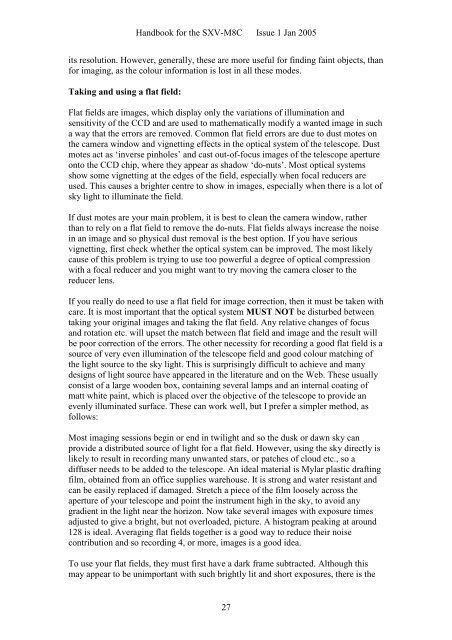SXV-M8C handbook.pdf - Starlight Xpress
SXV-M8C handbook.pdf - Starlight Xpress
SXV-M8C handbook.pdf - Starlight Xpress
- No tags were found...
Create successful ePaper yourself
Turn your PDF publications into a flip-book with our unique Google optimized e-Paper software.
Handbook for the <strong>SXV</strong>-<strong>M8C</strong> Issue 1 Jan 2005its resolution. However, generally, these are more useful for finding faint objects, thanfor imaging, as the colour information is lost in all these modes.Taking and using a flat field:Flat fields are images, which display only the variations of illumination andsensitivity of the CCD and are used to mathematically modify a wanted image in sucha way that the errors are removed. Common flat field errors are due to dust motes onthe camera window and vignetting effects in the optical system of the telescope. Dustmotes act as ‘inverse pinholes’ and cast out-of-focus images of the telescope apertureonto the CCD chip, where they appear as shadow ‘do-nuts’. Most optical systemsshow some vignetting at the edges of the field, especially when focal reducers areused. This causes a brighter centre to show in images, especially when there is a lot ofsky light to illuminate the field.If dust motes are your main problem, it is best to clean the camera window, ratherthan to rely on a flat field to remove the do-nuts. Flat fields always increase the noisein an image and so physical dust removal is the best option. If you have seriousvignetting, first check whether the optical system can be improved. The most likelycause of this problem is trying to use too powerful a degree of optical compressionwith a focal reducer and you might want to try moving the camera closer to thereducer lens.If you really do need to use a flat field for image correction, then it must be taken withcare. It is most important that the optical system MUST NOT be disturbed betweentaking your original images and taking the flat field. Any relative changes of focusand rotation etc. will upset the match between flat field and image and the result willbe poor correction of the errors. The other necessity for recording a good flat field is asource of very even illumination of the telescope field and good colour matching ofthe light source to the sky light. This is surprisingly difficult to achieve and manydesigns of light source have appeared in the literature and on the Web. These usuallyconsist of a large wooden box, containing several lamps and an internal coating ofmatt white paint, which is placed over the objective of the telescope to provide anevenly illuminated surface. These can work well, but I prefer a simpler method, asfollows:Most imaging sessions begin or end in twilight and so the dusk or dawn sky canprovide a distributed source of light for a flat field. However, using the sky directly islikely to result in recording many unwanted stars, or patches of cloud etc., so adiffuser needs to be added to the telescope. An ideal material is Mylar plastic draftingfilm, obtained from an office supplies warehouse. It is strong and water resistant andcan be easily replaced if damaged. Stretch a piece of the film loosely across theaperture of your telescope and point the instrument high in the sky, to avoid anygradient in the light near the horizon. Now take several images with exposure timesadjusted to give a bright, but not overloaded, picture. A histogram peaking at around128 is ideal. Averaging flat fields together is a good way to reduce their noisecontribution and so recording 4, or more, images is a good idea.To use your flat fields, they must first have a dark frame subtracted. Although thismay appear to be unimportant with such brightly lit and short exposures, there is the27
















